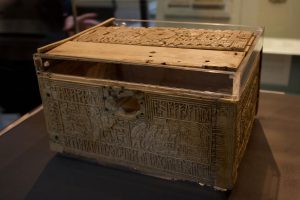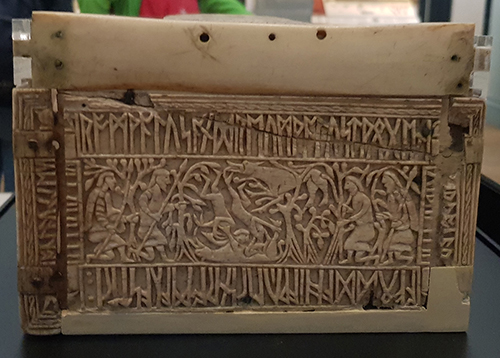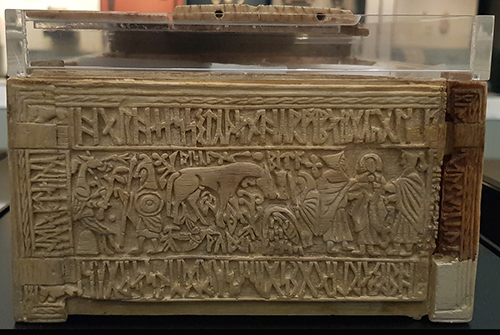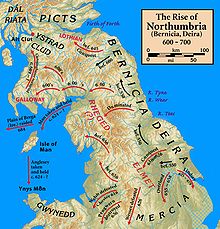
The Franks or Auzon Casket is an 8th century Anglo-saxon casket of probably Northmbrian origin. Its is a whalebone casket completely decorated on its 4 sides and the lid with runic inscriptions as well as images which portray both Christian and Pagan stories. The casket is about 23cmx 19cm x 11cm ins size. Its age has been deduced from the language used on the script that accompanies the illustrations. These are Latin as well as old English and the Futhorc runic script.
The panels that make up the casket were donated by a Sir Augusts Wollaston Franks to the British Museum in 1867. He was an antiquarian and a collector and considered one of the great Victorian collectors whose finds benefited the British Museum. Franks himself found the panels in an antique shop in Paris in 1857.
We know virtually nothing about the origins of the casket. It is believed to have probably been made in a monastery in Northumbria in the 8th century. What then happened to it is a mystery but it probably belonged to a church at some point before being looted in the French Revolution. It eventually turns up in the possession of a family in Auzon in the upper Loire which is why it is sometimes called the Auzon casket. It is thought it had been used as a sewing basket for some time. The casket was originally held together by hinges of silver which have been lost or sold as have the lock and some of the lid panels which may also have been silver. Without these the box was just loose panels. These turned up (minus one side panel) in an antique shop in Paris which is where Franks found them.
The missing panel was found in 1890 by the Auzon family who then sold it to a museum in Florence.
Thus the casket on display in the British Library consists of the 3 of the original panels, what is left of the lid and a cast of the missing panel.

Front panel of the casket
The front panel of the Franks casket shows two legends. On the left is the pagan Germanic myth of Wayland the Smith. Elements that can be made out include Wayland aparently crippled by his captor king Niohad working in the forge. At his feet is the body of the king’s son who Wayland kills. On the right Wayland captures birds whose feathers he uses to escape.
On the right is the Christian story of the Adoration of the Magi. Three kings/wisemen can be seen bearing gifts approaching the stable wherein a manger can be recognised and overhead a star is visible
The writing around the edge is a riddle about whale bone from which the casket is made.
The flood cast up the fish on the mountain-cliff
The terror-king became sad where he swam on the shingle.
Whale’s bone.

The rear panel.
The rear panel of the Franks casket shows the capure of Jerusalem by the Romans under Titus in AD 70. This event occured as part of the Roman-Jewish wars that followed an uprising by the Jews against Roman rule and eventually ends with destruction of their Temple. Why the panel shows this scene is unknown.

Left side panel.
The left side panel of the casket portrays the legend of Romulus and Remus and the she wolf. In the centre we can see the two boys being suckled by the she-wolf. She also is seen at the top protecting them from a hunting party. The text translates as:
Romulus and Remus, two brothers, a she-wolf nourished them in Rome, far from their native land.
Romulus and Remus go on to found Rome. There are paralells with Hengist and Horsa who found the first Anglo-Saxon kingdom in Kent. Thus it is thought by some that this scene is saying something about the destiny of the Anglo-Saxon invaders ruling Britain.

Right side panel
The right side panel of the Franks casket is the most confusing. At the far left a animal figure sits on a small hill or mound, and is approached by a warrior. In the centre is a horse and another figures. Finally on the right are three figures. Two of them seem to be holding the third captive. The text has never been entirely understood. It has elements that say something like:
Here sits Hos on/in the hill/barrow. She suffers distress as ??Ertae had imposed it upon her. A wretched den of sorrows and torments… wood/rushes.
Theories abound about this image. One idea is that this might be be a reference to the death of Horsa (often associated with the horse image), the brother of Hengist. He died in battle with the British. Is the text a reference to his mother mourning him? Is that warrior we can see his brother visiting his grave?
Other ideas are that ii is a now lost Pagan tale, others that it refers to Satan and hell.
We probably will never know.

The lid
Most of the lid of the Franks casket is missing. It is believed that panels of perhaps silver laid here above and below the remains. What is left is thought to show another Pagan legend. Again there are arguments as to what is protrayed. The only word visible is Egil. So many believe that this time it shows an archer, Aegil brother of Wayland the Smith defending a fortress from an attacking horde of giants (shown on the left). Other ideas is that Egil refers to Achilles in which case is this the scene where Achilles is shot by an arrow in his heel? If so this could be the fall of Troy which fits in which the panel showing Romulus and Remus who, exiled from Troy, go onto found Rome.
The Franks casket is a remarkable object. We may never know its full story – niether what happened to it in those missing centuries or exactly what it all means but if you are ever in the British Museum be sure to visit the Anglo-Saxon room as it and many other wonders are on display there.
News about my books
I am currently working on the 5th Northern Crown book which continues the story of Cerdic and his brother Hussa whose rivalry mirrors that between the Kingdoms of Bernicia and Deira over the destiny of one of the greatest of the Anglo-Saxon kingdoms: Northumbria. It was that land at the height of its power in the 7th to 8th Century that led to a treasures like the Franks Chest and was home to Bede and the site of the important Synod of Whitby. But the Northern Crown series tells the story not of those glory days but of that earlier struggle that created that kingdom. Explore the darkest years of the dark ages with Cerdic and Hussa. My next book will be out spring 2020.











